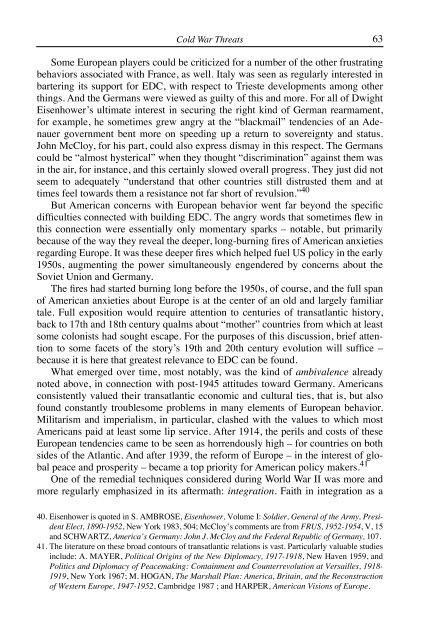journal of european integration history revue d'histoire de l ...
journal of european integration history revue d'histoire de l ...
journal of european integration history revue d'histoire de l ...
Create successful ePaper yourself
Turn your PDF publications into a flip-book with our unique Google optimized e-Paper software.
Cold War Threats 63<br />
Some European players could be criticized for a number <strong>of</strong> the other frustrating<br />
behaviors associated with France, as well. Italy was seen as regularly interested in<br />
bartering its support for EDC, with respect to Trieste <strong>de</strong>velopments among other<br />
things. And the Germans were viewed as guilty <strong>of</strong> this and more. For all <strong>of</strong> Dwight<br />
Eisenhower’s ultimate interest in securing the right kind <strong>of</strong> German rearmament,<br />
for example, he sometimes grew angry at the “blackmail” ten<strong>de</strong>ncies <strong>of</strong> an A<strong>de</strong>nauer<br />
government bent more on speeding up a return to sovereignty and status.<br />
John McCloy, for his part, could also express dismay in this respect. The Germans<br />
could be “almost hysterical” when they thought “discrimination” against them was<br />
in the air, for instance, and this certainly slowed overall progress. They just did not<br />
seem to a<strong>de</strong>quately “un<strong>de</strong>rstand that other countries still distrusted them and at<br />
times feel towards them a resistance not far short <strong>of</strong> revulsion.” 40<br />
But American concerns with European behavior went far beyond the specific<br />
difficulties connected with building EDC. The angry words that sometimes flew in<br />
this connection were essentially only momentary sparks – notable, but primarily<br />
because <strong>of</strong> the way they reveal the <strong>de</strong>eper, long-burning fires <strong>of</strong> American anxieties<br />
regarding Europe. It was these <strong>de</strong>eper fires which helped fuel US policy in the early<br />
1950s, augmenting the power simultaneously engen<strong>de</strong>red by concerns about the<br />
Soviet Union and Germany.<br />
The fires had started burning long before the 1950s, <strong>of</strong> course, and the full span<br />
<strong>of</strong> American anxieties about Europe is at the center <strong>of</strong> an old and largely familiar<br />
tale. Full exposition would require attention to centuries <strong>of</strong> transatlantic <strong>history</strong>,<br />
back to 17th and 18th century qualms about “mother” countries from which at least<br />
some colonists had sought escape. For the purposes <strong>of</strong> this discussion, brief attention<br />
to some facets <strong>of</strong> the story’s 19th and 20th century evolution will suffice –<br />
because it is here that greatest relevance to EDC can be found.<br />
What emerged over time, most notably, was the kind <strong>of</strong> ambivalence already<br />
noted above, in connection with post-1945 attitu<strong>de</strong>s toward Germany. Americans<br />
consistently valued their transatlantic economic and cultural ties, that is, but also<br />
found constantly troublesome problems in many elements <strong>of</strong> European behavior.<br />
Militarism and imperialism, in particular, clashed with the values to which most<br />
Americans paid at least some lip service. After 1914, the perils and costs <strong>of</strong> these<br />
European ten<strong>de</strong>ncies came to be seen as horrendously high – for countries on both<br />
si<strong>de</strong>s <strong>of</strong> the Atlantic. And after 1939, the reform <strong>of</strong> Europe – in the interest <strong>of</strong> global<br />
peace and prosperity – became a top priority for American policy makers. 41<br />
One <strong>of</strong> the remedial techniques consi<strong>de</strong>red during World War II was more and<br />
more regularly emphasized in its aftermath: <strong>integration</strong>. Faith in <strong>integration</strong> as a<br />
40. Eisenhower is quoted in S. AMBROSE, Eisenhower, Volume I: Soldier, General <strong>of</strong> the Army, Presi<strong>de</strong>nt<br />
Elect, 1890-1952, New York 1983, 504; McCloy’s comments are from FRUS, 1952-1954, V, 15<br />
and SCHWARTZ, America’s Germany: John J. McCloy and the Fe<strong>de</strong>ral Republic <strong>of</strong> Germany, 107.<br />
41. The literature on these broad contours <strong>of</strong> transatlantic relations is vast. Particularly valuable studies<br />
inclu<strong>de</strong>: A. MAYER, Political Origins <strong>of</strong> the New Diplomacy, 1917-1918, New Haven 1959, and<br />
Politics and Diplomacy <strong>of</strong> Peacemaking: Containment and Counterrevolution at Versailles, 1918-<br />
1919, New York 1967; M. HOGAN, The Marshall Plan: America, Britain, and the Reconstruction<br />
<strong>of</strong> Western Europe, 1947-1952, Cambridge 1987 ; and HARPER, American Visions <strong>of</strong> Europe.

















